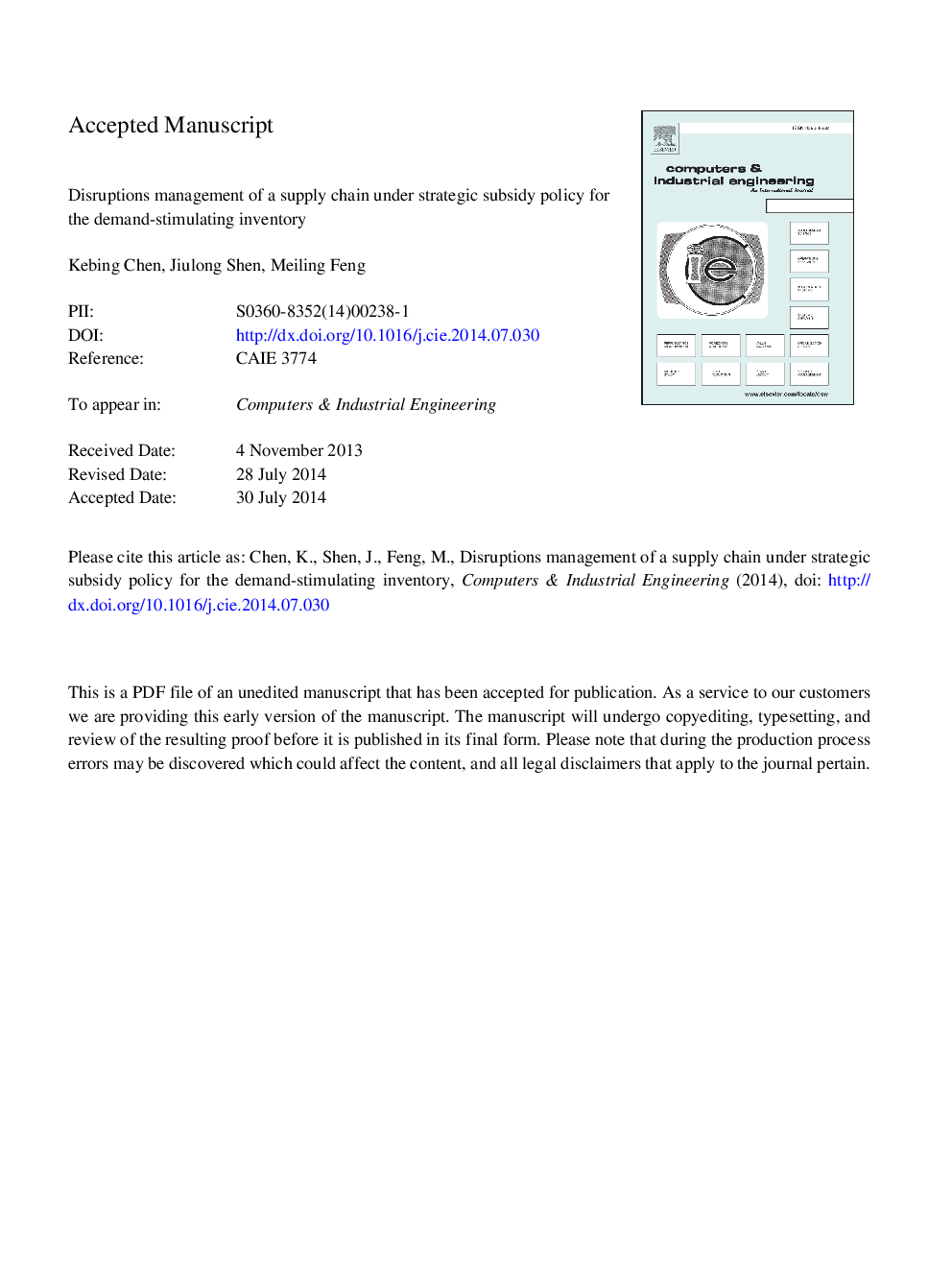| کد مقاله | کد نشریه | سال انتشار | مقاله انگلیسی | نسخه تمام متن |
|---|---|---|---|---|
| 7542325 | 1489090 | 2014 | 35 صفحه PDF | دانلود رایگان |
عنوان انگلیسی مقاله ISI
Disruptions management of a supply chain under strategic subsidy policy for the demand-stimulating inventory
ترجمه فارسی عنوان
مدیریت اختلالات زنجیره تامین تحت سیاست های یارانه ای استراتژیک برای موجودی تحریک کننده تقاضا
دانلود مقاله + سفارش ترجمه
دانلود مقاله ISI انگلیسی
رایگان برای ایرانیان
کلمات کلیدی
ترجمه چکیده
این مقاله یک مدل بازی از یک تولید کننده و یک خرده فروش با تقاضا را بسته به مقدار موجودی نمایش داده شده در قفسه خرده فروش معرفی می کند. ما در حال بررسی مکانیزم هماهنگی زنجیره تامین با دو نوع اختلال است. برای هماهنگ کردن کانال و همچنین ایجاد سود، تولید کننده باید اهرم قیمت عمده فروشی را به دیگری افزایش دهد، یعنی یارانه نگهداری موجودی به خرده فروش. ما نشان می دهیم که قرارداد موجودی یارانه ای برای وضعیت اختلال (ها) منطقی و محدودی دارد: از دیدگاه تجزیه و تحلیل امکان سنجی، متوجه می شویم وقتی که هزینه خراب نگه داشتن موجودی بیشتر از یک مقدار آستانه مشخص است، هر دو بازیکن می توانند با استفاده از قرارداد موجودی-یارانه برنده شوید. در غیر این صورت، ممکن است بی اثر باشد. برای اختلال دو عامل، برخی از محدودیت های متقابل بین هزینه های نگهداری موجودی خراب شده و تقاضای متفرق شده در هنگام استفاده از مکانیسم هماهنگی وجود دارد. ما همچنین می بینیم که هر دو وضعیت اختلال، دارای مقیاس های قوی خود هستند، که تولید کننده نباید طرح اصلی تولید را تغییر دهد، بلکه باید از طریق ارائه یک طرح یارانه ای جذاب به خرده فروش. جالب توجه است، برخی از بینش های مدیریتی ضد بصری را می توان در مقیاس های قوی مشاهده کرد. برای مثال، تقاضای بازار با سطح موجودی نمایش داده شده در تنظیم موجودی تحریک کننده تقاضا افزایش می یابد. با این حال، تقاضای بالاتر، سطح موجودی نمایش داده شده کمتر در مقیاس قوی خواهد بود.
موضوعات مرتبط
مهندسی و علوم پایه
سایر رشته های مهندسی
مهندسی صنعتی و تولید
چکیده انگلیسی
This paper introduces a game model of one manufacturer and one retailer with the demand depending on the amount of inventory displayed on the retailer's shelf. We study coordination mechanisms of the supply chain with the two kinds of disruptions. To coordinate the channel as well as make a profit, the manufacturer needs to augment the wholesale price lever by another, i.e., an inventory-holding cost subsidy to the retailer. We show that the inventory-subsidy contract for disruption(s) situation has its rationality and limitation: from the perspective of feasibility analysis, we find that when the disrupted amount of inventory-holding cost is larger than a certain threshold value, both players can achieve win-win by using inventory-subsidy contract. Otherwise, it may be ineffective. For two-factor disruptions, there are some mutual restraints between the disrupted inventory-holding cost and the disrupted demand when the coordination mechanism is used. We also find that both disruption situations have their own robust scales, in which the manufacturer should not change the original production plan but at the expense of providing a more attractive subsidy scheme to the retailer. Interestingly, some counter-intuitive managerial insights can be observed in robust scales. For example, the market demand increases with the displayed inventory level in the setting of the demand-stimulating inventory. However, the higher the demand, the less displayed inventory level will be in the robust scale.
ناشر
Database: Elsevier - ScienceDirect (ساینس دایرکت)
Journal: Computers & Industrial Engineering - Volume 76, October 2014, Pages 169-182
Journal: Computers & Industrial Engineering - Volume 76, October 2014, Pages 169-182
نویسندگان
Kebing Chen, Jiulong Shen, Meiling Feng,
